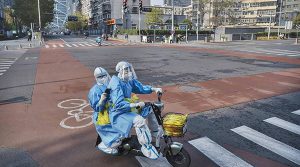Bloomberg
China’s soaring Covid infections are keeping people home and causing a slump in travel and economic activity, according to the latest high-frequency data.
Following the recent abrupt end to Covid Zero controls, more cities have been hit by an exit wave of infections in the past week, leading to crowded hospitals and queues at funeral parlours. That’s keeping people in Beijing, Shanghai and elsewhere from going out despite workers in some places being told to return to work even
if sick.
Several measures of mobility including traffic congestion in major cities, subway usage and the number of domestic flights have all slumped.
In recent days subway passenger numbers have plummeted in cities including Shanghai, Guangzhou, Shenzhen, Xi’an and Nanjing as infections surged, while in Beijing, one of the cities that experienced the infection wave the earliest, subway usage steadied and picked up slightly over the past four days, although it is still around 80% below the level on the same period in 2019.
Congestion levels across 15 major cities are 56% below the level in January 2021, the benchmark used in an index compiled by BloombergNEF based on Baidu Inc traffic data. That’s worse than during the lockdown of Shanghai and other cities in the spring.
The only other time this year it’s been lower was in early February, when the Lunar New Year period saw factories and restaurants close and people leave big metropolises to return home.
“The spike in Covid-19 infection rates following the easing of mobility restrictions will still constrain economic activity in the December-January time frame,†which is consistent with the experience of other Asian economies, said Guan Yi Low, head of fixed income for Asia Pacific at M&G Investments.
The economy is set for more pain and uncertainty as the wave of infections spreads, with the lack of trustworthy statistics on cases and deaths making it difficult to predict when the outbreak might peak or start to wane.
 The Gulf Time Newspaper One of the finest business newspapers in the UAE brought to you by our professional writers and editors.
The Gulf Time Newspaper One of the finest business newspapers in the UAE brought to you by our professional writers and editors.
